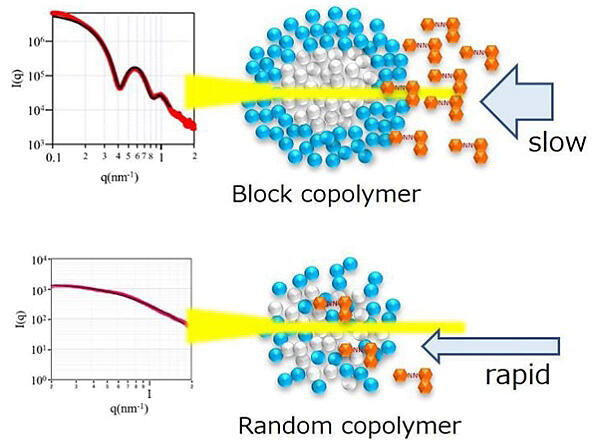A research group comprising Professor Hidenori Otsuka of the Department of Applied Chemistry, Faculty of Science and Graduate Student Masahiko Asada of the Department of Chemistry, Graduate School of Science at Tokyo University of Science announced that they conducted a structural analysis of polymer micelles. The research group found that block copolymer micelles form a core-shell structure while random copolymer micelles form a random coil structure. The block copolymer micelles exhibited a slower dye solubilization rate than the random copolymer micelles and solubilized a larger number of dyes, demonstrating their superior dye solubilization ability. This finding is expected to be applied to drug delivery systems for pharmaceuticals and pigment dispersion. The results were published in the international journal Soft Matter.

Provided by Tokyo University of Science
Copolymers obtained by copolymerizing multiple monomers are classified as block or random copolymers depending on the arrangement of the monomers. These polymers and micelles are used in various fields, including the chemical industry and medicine. Micelles are aggregates formed in water by molecules that possess hydrophilic and hydrophobic properties (amphiphilic). In water, these molecules form spherical or circular structures, with the hydrophilic groups facing outward and hydrophobic groups facing inward. Conventional inks contain many volatile organic compounds and have a high environmental impact. Although the use of water-based or vegetable-based inks is being considered as an alternative, improvements in the pigment dispersion and stability of polymers in the ink are considered essential to achieve this.
In this research, the group investigated the correlation between the micelle structure and dye solubilization behavior to establish a basis for designing polymers that improve pigment dispersion. Specifically, five amphiphilic block polymers (BL01-05) and four random copolymers (RD01-04) were prepared, and the structures and properties of the micelles formed by these copolymers were comprehensively investigated. Consequently, a core-shell structure with continuous interfaces in all block copolymers (micelles formed by copolymers comprising blocks in which different monomers are bonded in succession from the ends of the blocks of one monomer continuously bonded together) was formed. Meanwhile, the random copolymers (micelles formed by copolymers made of different monomers randomly arranged in a polymer chain) formed a random coil structure, unlike the block copolymers.
To determine the polarity and critical micelle concentration inside polymer micelles, fluorescence measurements were performed on mixed aqueous solutions of each polymer and pyrene. The measurements confirmed that the block copolymers form a core-shell structure with a highly hydrophobic micelle core, while the random copolymers form a structure without a clear core. Therefore, the block copolymers showed a greater ability to dissolve hydrophobic compounds than the random copolymers.
The UV-visible absorption spectra were used to measure the time variation of the solubilization number of oil-based dyes in aqueous polymer solutions. The results revealed that the block copolymers tended to have higher solubilization amount than the random copolymers. In terms of the solubilization rate (time to saturation), the block copolymers were slower than the random copolymers, suggesting that the core-shell structure prevented dye penetration. The larger the micelle size and core size and the greater the number of associations, the greater the amount of solubilization the clearer the contrast at the core-shell interface, and the slower the dye solubilization rate.
Otsuka said, "The rate of the dynamic equilibrium of micelles formed by low molecular weight surfactants is well known, but how stable are polymeric surfactants? We conducted this research to answer this question. We believe that our findings will have a tremendous impact on the industry, which focuses on in vivo stability and microparticle dispersion in pharmaceutical drug delivery systems."
Journal Information
Publication: Soft Matter
Title: Investigating the effect of the micelle structures of block and random copolymers on dye solubilization
DOI: 10.1039/d4sm00009a
This article has been translated by JST with permission from The Science News Ltd. (https://sci-news.co.jp/). Unauthorized reproduction of the article and photographs is prohibited.




